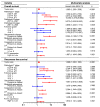High expression of FUT3 is linked to poor prognosis in clear cell renal cell carcinoma
- PMID: 28977844
- PMCID: PMC5617404
- DOI: 10.18632/oncotarget.17717
High expression of FUT3 is linked to poor prognosis in clear cell renal cell carcinoma
Abstract
Background and purpose: Some of the fucosylation catalyzed by fucosyltransferase-III mediates the epithelial-mesenchymal transition and enhances tumor cell-macrophage signaling, which promotes malignant transforming and immune evasion. The aim of the study was to investigate the association between the expression of fucosyltransferase-III and clinical outcomes of patients with clear-cell renal cell carcinoma after surgery.
Results: High fucosyltransferase-III expression was associated with a greater risk of recurrence (p = 0.002) and shortened overall survival (p < 0.001). We then established a prognostic nomogram including tumor size, pathologic T, N, M stage, coagulative necrosis, lymphovascular invasion and fucosyltransferase-III expression. Furthermore, the predictive accuracy of the Leibovich prognostic score was improved when fucosyltransferase-III expression was added (p = 0.009 for overall survival and p = 0.002 for recurrence-free survival).
Materials and methods: We conducted a retrospective cohort study of 406 patients who underwent partial or radical nephrectomy between January 2008 and December 2009 in a single institute. Fucosyltransferase-III expression levels were evaluated by immunohistochemical staining in tumor tissues. Kaplan-Meier method was applied to compare survival curves. Cox regression models were fitted to analyze the effect of prognostic factors on recurrence-free and overall survival. Harrell's concordance index and Akaike's Information Criteria were calculated to assess predictive accuracy.
Conclusions: Fucosyltransferase-III is a predictive factor for poor overall survival and recurrence free survival in patients with ccRCC. The inhibitor of fucosyltransferase-III might be a potential therapeutic method for the disease.
Keywords: clear cell renal cell carcinoma; fucosyltransferase-III; overall survival; prognosis; recurrence free survival.
Conflict of interest statement
CONFLICTS OF INTEREST The authors declare no conflicts of interest.
Figures





Similar articles
-
High expression of chemokine CCL2 is associated with recurrence after surgery in clear-cell renal cell carcinoma.Urol Oncol. 2016 May;34(5):238.e19-26. doi: 10.1016/j.urolonc.2015.11.026. Epub 2015 Dec 31. Urol Oncol. 2016. PMID: 26749463
-
High APOBEC3B expression is a predictor of recurrence in patients with low-risk clear cell renal cell carcinoma.Urol Oncol. 2015 Aug;33(8):340.e1-8. doi: 10.1016/j.urolonc.2015.05.009. Epub 2015 Jun 4. Urol Oncol. 2015. PMID: 26051357
-
Elevated Expression of N-Acetylgalactosaminyltransferase 10 Predicts Poor Survival and Early Recurrence of Patients with Clear-Cell Renal Cell Carcinoma.Ann Surg Oncol. 2015 Jul;22(7):2446-53. doi: 10.1245/s10434-014-4236-y. Epub 2014 Nov 13. Ann Surg Oncol. 2015. PMID: 25391266
-
External validation of the Leibovich prognosis score for nonmetastatic clear cell renal cell carcinoma at a single European center applying routine pathology.J Urol. 2011 Nov;186(5):1773-7. doi: 10.1016/j.juro.2011.07.034. Epub 2011 Sep 25. J Urol. 2011. PMID: 21944989
-
p21-activated kinase 1 predicts recurrence and survival in patients with non-metastatic clear cell renal cell carcinoma.Int J Urol. 2015 May;22(5):447-53. doi: 10.1111/iju.12715. Epub 2015 Feb 24. Int J Urol. 2015. PMID: 25711487
Cited by
-
Glycosylation in Renal Cell Carcinoma: Mechanisms and Clinical Implications.Cells. 2022 Aug 20;11(16):2598. doi: 10.3390/cells11162598. Cells. 2022. PMID: 36010674 Free PMC article. Review.
-
The Role of Glycosyltransferases in Colorectal Cancer.Int J Mol Sci. 2021 May 30;22(11):5822. doi: 10.3390/ijms22115822. Int J Mol Sci. 2021. PMID: 34070747 Free PMC article. Review.
-
Low level of isocitrate dehydrogenase 1 predicts unfavorable postoperative outcomes in patients with clear cell renal cell carcinoma.BMC Cancer. 2018 Aug 28;18(1):852. doi: 10.1186/s12885-018-4747-1. BMC Cancer. 2018. PMID: 30153799 Free PMC article.
-
A Comprehensive Prognostic Analysis of Tumor-Related Blood Group Antigens in Pan-Cancers Suggests That SEMA7A as a Novel Biomarker in Kidney Renal Clear Cell Carcinoma.Int J Mol Sci. 2022 Aug 8;23(15):8799. doi: 10.3390/ijms23158799. Int J Mol Sci. 2022. PMID: 35955933 Free PMC article.
-
Role of tumor cell sialylation in pancreatic cancer progression.Adv Cancer Res. 2023;157:123-155. doi: 10.1016/bs.acr.2022.07.003. Epub 2022 Sep 27. Adv Cancer Res. 2023. PMID: 36725107 Free PMC article. Review.
References
-
- Ljungberg B, Campbell SC, Choi HY, Jacqmin D, Lee JE, Weikert S, Kiemeney LA. The epidemiology of renal cell carcinoma. Eur Urol. 2011;60:615–21. Erratum in: Eur Urol. 2011; 60:1317. - PubMed
-
- Chen W, Zheng R, Baade PD, Zhang S, Zeng H, Bray F, Jemal A, Yu XQ, He J. Cancer statistics in China, 2015. CA Cancer J Clin. 2016;66:115–32. - PubMed
-
- Motzer RJ, Bander NH, Nanus DM. Renal-cell carcinoma. N Engl J Med. 1996;335:865–75. - PubMed
-
- Naitoh J, Kaplan A, Dorey F, Figlin R, Belldegrun A. Metastatic renal cell carcinoma with concurrent inferior vena caval invasion: long-term survival after combination therapy with radical nephrectomy, vena caval thrombectomy and postoperative immunotherapy. J Urol. 1999;162:46–50. - PubMed
LinkOut - more resources
Full Text Sources
Other Literature Sources

